Canon 7 Rangefinder Camera
A Description of the Canon 7 Rangefinder Camera 1961-1964

Canon 7 fitted with a Canon 35mm f1.5 lens
The Canon 7 Rangefiner 1961-1964
Peter Dechert 1 stated that the Canon 7 had a longer development period than any previous Canon rangefinder. It also was a "clean slate" design using a completely new concept of body, rangefinder and viewfinder, and lens selection. It was 'state of the art' on its release in 1961.
Canon 7 Features
The most obvious change in the Canon 7 was the inclusion of a large selenium exposure meter across the top front half of the camera. The light meter measurement from this selenium cell was read from a semi-circular meter on the camera top.
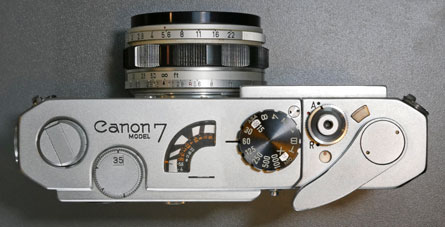
Canon 7 top with (l to r) rewind knob, selector dial for viewfinder focal length, light meter, shutter speed, shutter release, film counter, lever film advance
also, there is a little red dot inside the small window just below the shutter release which rotates as the film advances
The photographer would first set the ASA/DIN speed of the film in the shutter speed dial, then read the light meter. Rotating the shutter speed dial would allign f-stop readings with the light meter needle, allowing the photographer to choose the preferred shutter speed-f-stop combination. With the shutter speed set, the photographer would then set the indicated f-stop. The light meter also had a selection between bright light readings and low-light readings.
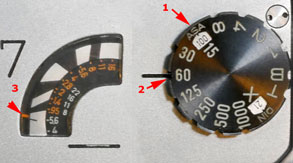
the photographer (1) sets film speed (2) sets shutter speed (3) reads f-stop from light meter
Canon 7 Viewfinder
In its use, a dramatic improvement was the new Canon 7 viewfinder. The viewfinder gave individual lens focal length views selected by the viewfinder selector on camera top. The viewfinder showed projected frames which were parallax corrected. The 35mm frame, 50mm frame and 135mm frame were each displayed independently set by the viewfinder switch. 85mm and 100mm frames were displayed together. Image size was about 70% of life-size. Each focal length was also shown in the projected frames in the viewfinder to aid the photographer.
The rangefinder accuracy was improved by lengthening the base by +50%, providing accuracy for both telephoto lenses and the massive new Canon 50mm f0.95 lens.
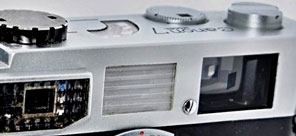
1961 Canon 50mm f0.95 Lens
In June 1961, Canon released the 50mm f0.95 lens which would couple with the new Canon 7 camera. This new lens was indeed a milestone and was by far the fastest lens of that time. Because of its speed, the Canon 50mm f0.95 was used not only for 35mm photography, but also widely used for television cameras and for cinematography.
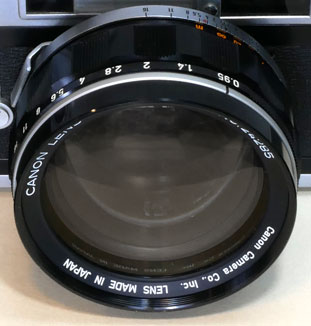
This lens, because of it very large size, used a new coupling bracket located on the outside of the usual M39 lens flange. This bracket was used only for the Canon 50mm f0.95 lens.
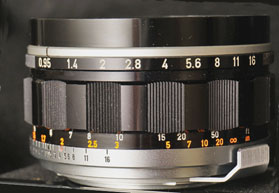
the coupling bracket for the Canon 50mm f0.95
Accessory Shoe
The Canon 7 was widely acclaimed and widely sold. However, there was one complaint: the lack of an accessory shoe. The accessory shoe was usually used for separate finders for long or short focal lenses and for flash units. Canon developed a flash unit that would couple to the flash connector socket on the side of the camera, but there continued to be a demand for an accessory shoe. Canon therefore developed what was an unusual (and today rare to find) bracket which could attach to the flash connector socket and lay over the camera top with an accessory shoe. This attachment had a further flash connector socket in its structure, and also an opening so that the light meter reading could be seen. This problem would later be solved by the launch of the Canon 7s with a usual accessory shoe.
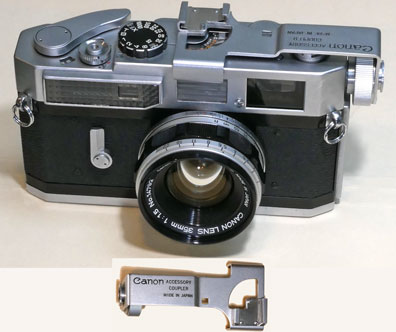
Success of the Canon 7
The launch of the Canon 7 in 1961 was at the time of the strong movement of photography from rangefinder cameras to the single lens reflex. Nikon had stopped rangefinder camera production the year before in 1960 and Canon had launched its Canonflex in June 1959. In spite of this trend towards single lens reflex cameras, the Canon 7 sold 137,000 units, the highest sales count of any Canon rangefinder and more even the the Canon P. It is striking that this unit sales of the Canon 7 was more than the sales of all the Nikon rangefinders of all models of the 1950s, until Nikon discontinued rangefinders in 1959. 16.
The Canon 7 was further succeded by the superb Canon 7s, about which you can read by clicking the link below.

Canon 7 with the excellent Canon 50mm f1.4 lens of 1961
You can click on the links in the table below to consult other pages of the canonrangfinder.org site.
| Navigation: Click Below to Jump to Desired Subject Page | ||
|---|---|---|
| Canon Rangefinder Cameras - 1 | Canon Rangefinder Cameras - 2 | Canon Rangefinder Lenses |
| Canon S | Canon IVSB2 | Canon 19mm |
| Canon J | Canon IIS2, IID2, IIF2 | Canon 25mm |
| Canon NS | Canon VT, Canon L2 | Canon 28mm |
| Canon JS | Canon L1, L3 | Canon 35mm |
| Canon J-II | Canon VT Deluxe | Nikkor 50mm |
| Canon S-II | Canon VL, VL2 | Canon 50mm |
| Canon IIB | Canon VI-L, VI-T | Canon 85mm |
| Canon III, IIC, IV | Canon P | Canon 100mm |
| Canon IIIA, IVF, IVS | Canon 7 | Canon 135mm |
| Canon IIA, IID, IID1 | Canon 7s | Canon 200mm-1000mm |
| Canon IVSB | Minolta Rangefinders | Minolta Lenses |
| Canon IIF, IIS | Other Rangefinders | other M39 lenses |
| Go to canonrangefinder.com home page | ||
Any additions or corrections to these pages would be welcome simply by contacting this site as shown at the foot of this page .
Footnotes: 1 Dechert, Peter. Canon Rangefinder Cameras 1933-1968. Hove Collectors Books. West Sussex, United Kingdom. 1985. ISBN 0-906447-30-5.
Peter Dechert's book is the most important expert source of information regarding Canon Rangefinder Cameras.
2 Kitchingman, Peter. Canon M39 Rangefinder Lenses 1939-1971. A Collector's Guide. Published by Peter Kitchingman. Perth, Australia. 2008. ISBN 978-0-646-48144-9.
Peter Kitchingman's book is the definitive study of the more than three decades of M39 format camera lenses developed for Canon Rangefinder Cameras.
3 Nostalgic Canon Camera Book. 懐かしいキヤノン EI Publishing Co. Ltd. Tokyo, Japan. June 2003.
Peter Kitchingman's book is the definitive study of the more than three decades of M39 format camera lenses developed for Canon Rangefinder Cameras.
4 "Canon Camera Museum" history website. https://global.canon/en/c-museum/history/ published by Canon, Inc. accessed in 2019.
5 Rajner, Hans P. (author), John Wade (editor). Leica Copies. Classic Collections Publications. London, UK. ISBN 13: 9781874485056
Hans P. Rajner's book is an excellently detailed and carefully researched study of camera from around the world which used the Leica M39 lens mount and the same lens to film plane distance.
7 Dechert, Peter. Canon Single Lens Reflex Cameras 1959-1991. Historical Camera Publications. Yakima, Washington. 1992. ISBN 1-879561-04-2.
8 Tomlinson, Shawn M. The Film Photography Book. Lulu Pulbications. 2016. ISBN: 9781365263972
9 Sartorius, Ghester. Identifying Leica Lenses. Classic Camera 19. Tokyo, Japan. 2001. ISBN 4-257-12029-0
10 website http://www.nicovandijk.net/rflensmatrix.htm consulted 2019.
11 O'Reagan, Douglas M. Allied Exploitation of German Science after World War II. Johns Hopkins University Press. Baltimore, Maryland. 2019. ISBN 9781421428888
12 website www.canonrangefinder.servehttp.com consulted 2008.
13 Minolta expert Andrea Aprà has posted information on minoltarangefinders group and other groups and further detailed information by email. (thanks Andrea !)
14 website http://www.collection-appareils.fr/objectifs/ consulted 2019.
15 Small, Marc James. Non-Leitz Leica Thread-Mount Lenses. Wittig Books. Hückelhoven, Germany. 1997. ISBN 3-930359-47-2.
16 the Nikon Corporation website: https://imaging.nikon.com/history/ consulted 2019.
17 p 152. Ray, Sidney F. Photographic Lens ISBN 9780240510323
18 website http://www.rokkorfiles.com/Lens%20History.html accessed 2019
If you have any comments or questions about this Canon Rangefinder site, please e-mail me (Larry Huffman) at e-mail address: [email protected]